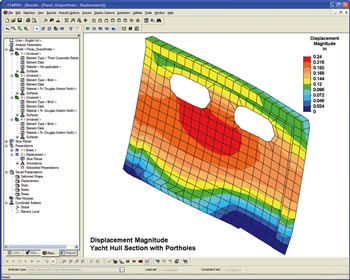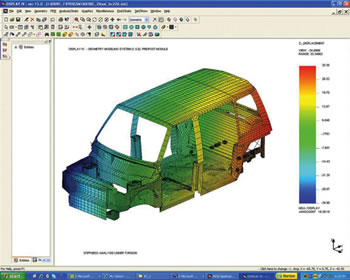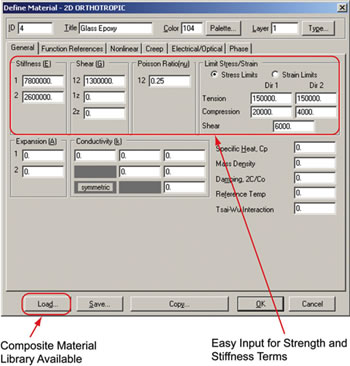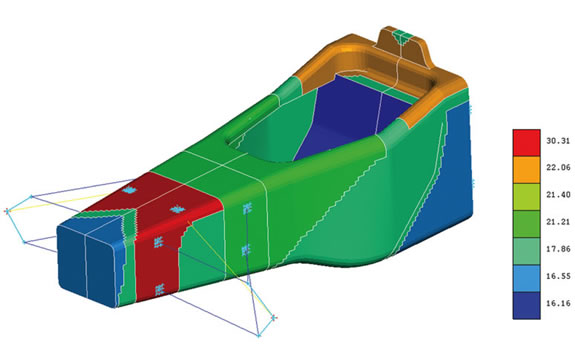Latest News
May 1, 2007
By Pamela J. Waterman
If the movie The Graduate were to be remade today, the classic bit of sage advice imparted to Ben Braddock by a family friend might well be: “Composites…. There is a great future in composites.”
Using composite materials can yield terrific benefits in most industries. One example is the decreased fuel consumption in the new Boeing 787 Dreamliner, which was designed with a lightweight, composite fuselage and wings. When working with such materials, however, any analysis must properly handle the nuances in composite component design, manufacture, and functional life. DE takes a look at these materials, the issues that arise when designing with them, and some software to help you do the job.
Defining Composites
On a macroscopic scale, composites have been around for centuries, whether in the form of straw-clay bricks or a concrete-aggregate roadway. In mechanical design applications, composites are engineered materials comprising reinforcement fibers, particles, flakes, and the like embedded in a supporting matrix of polymers, metals or ceramics. The matrix is the bonding element that can be shaped, while the reinforcement enhances the material properties of the matrix. Properly designed, the new material has properties superior to those of either original material alone, such as higher stiffness or better strength-to-weight ratios.
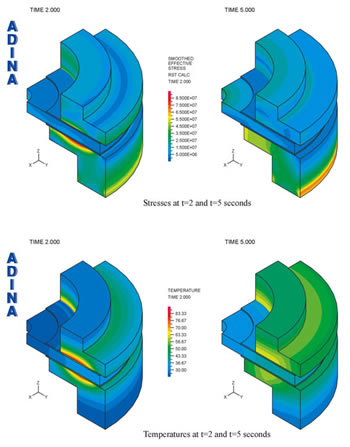 |
| This image shows the effective stresses and temperatures at two time instants during a braking simulation using ADINA. |
In this article we’ll discuss materials with embedded fibers such as fiberglass, quartz, Kevlar or, most typically, carbon (though some analysis programs handle other types and combinations like wood with fiberglass). The matrix component is usually an epoxy or polymide-resin that transfers the load between broken fibers and unbroken ones, and between fibers not oriented along the lines of tension. Fibers serve to resist tension, the matrix resists shear, and in combination, the new material resists compression.
Such aerospace-grade materials are formed to the end-shape, and generally require heat and pressure for manufacturing. Molding and casting are two common processes, and the end product (individual layers or plies) can be further laid up (laminated) to achieve final performance specifications. Each ply has its own material properties, fiber orientation, and thickness.
Possible advantages of using composites as compared to traditional metals and alloys include reduced costs due to lower production costs, long-term durability and reduced maintenance requirements; lighter weight or the possibility to readily create non-uniform weight distributions; higher strength-to-weight ratios and directional strength or stiffness; the opportunity to design larger, single-piece parts with unusual geometries; corrosion or weather resistance; low thermal conductivity and coefficient of expansion; and non-magnetic, high-dielectric strength.
Issues in Composite Design and End Use
A critical task while specifying composites is getting accurate material properties. This data usually requires actual testing of the responses of each ply to the applied load depending on its orientation. Once you have this information, you can define each layer with its own properties, apply the loads, construct a mesh, and perform the finite element analysis (FEA). The results describe the strength in the x,y,z directions, since it can be different for each one.
Designing with these materials also requires understanding conditions (such as shock, impact, loadings, or repeated cyclic stresses) that might cause delamination and degrade performance, either immediately or in the future. Safety results are not as simple to interpret as for a pure metal: analysis includes identifying the ply that will exhibit first failure. Also, the material can fracture because of fatigue or individual fibers might separate from the matrix due to an impact that leaves barely visible surface damage. Routine inspection scheduling may have to change when composites are in use.
Lastly, manufacturers of both the raw material and end parts must understand each step of the manufacturing process because high temperatures and pressures often create shrinkage or bowing (called springback) in the final part. Such changes in shape must be predicted and taken into account. Designers must also specify the orientation and placement of individual plies during the actual lamination (assembly) sequence.
| Resources in the Composites World Plastics, Composites, and Coatings Community |
Composite Design and Analysis Software
The good news is that many software companies have years of experience working with such materials, and offer standard packages to help designers, analysts, and manufacturers make the most of using composites. Following are some brief examples.
ADINA analysis software models composites in general terms using both layered shell and solid elements. It can solve fracture mechanics problems, examining both linear and nonlinear material characteristics, and simulate dynamic crash and crush problems. ADINA’s mesh-gluing feature allows multi-scale analyses, making it easy to connect regions with dissimilar meshes. Complex analyses include fluid-structure interactions, and the software also models thermo-mechanical coupling, a feature that is useful if the composite undergoes high thermal loads or gradients.
ALGOR software offers two key functions for handling composite material features. Its structural analysis capabilities for static stress (with linear and nonlinear models, linear dynamics, and fatigue), and its mechanical event simulation (for nonlinear, multi-body dynamics with large-scale motion, large deformation, and large strain with body-to-body contact) offer element types and material models specifically designed for composite laminate materials. It also has a Material Library Manager, which provides the capability to automatically import custom material properties from commercial services such as MatWeb and Matereality, and is compatible with industry-standard NASTRAN input and output files.
Since composite layers can have different orthotropic material properties and orientations, ANSYS offers solutions for modeling layered shells and solids through generalized section definitions. These definitions specify layer properties, orientation, and failure- and cohesive-zone materials or models for studying delaminations. ANSYS also offers interfaces to third-party applications such as FIBERSIM (from Vistagy) for importing composites information from draping analysis, MOLDFLOW (Moldflow) for importing fiber orientation and residual stress data from injection molding analyses, and DIGIMAT (e-Xstream Engineering) for advanced multi-scale material modeling.
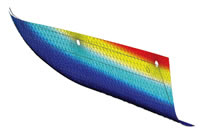 This COMSOL Multiphysics analysis of the viscoelastic behavior of a polymer resin airplane fairing strut during the cure cycle evaluates for final shape and residual stresses. The part undergoes various temperature/ cure cycles to find the one with the best results. |
COMSOL Multiphysics software can model the viscoelastic behavior of a polymer resin structure during the cure cycle of composite parts. Users can evaluate these models by exposing different resin compositions to various temperature and curing cycles to find the one with the best characteristics. This process accounts for both thermal and shrinkage effects, and predicts the interaction between the mold and the part during manufacturing. Such models can also evaluate the final shape and residual stresses on a part following the curing cycle.
With the COSMOS Advanced Professional package, users can input different material properties per layer, apply loads, do the meshing, and perform the analysis. They can compare stress values for each layer in all three directions (orthotropic properties), and review results versus maximum stress and strength criteria. COSMOS Advanced Professional also accommodates “sandwich” composites, where a material with very different properties (e.g., a honeycomb) is placed between top and bottom layers of metal or another material.
Initial input and verification of the complex layering sequence is one of the most difficult tasks for analysis engineers. NISA software, from Cranes Software, allows users to rearrange or modify the lamination sequence in its preprocessing program to optimize the design. Calculating the subsequent stresses and strains in an FEA study of each ply results in large amounts of data that need to be analyzed and sorted in order to understand the behavior of composite parts and assemblies. NISA allows users to sort through this data and pinpoint problem areas that need further investigation, thus ultimately optimizing the design.
The ESI Group markets a set of simulation tools that define and optimize the manufacturing processes for composite parts. PAM-FORM helps with draping, thermoforming, and diaphragm-forming processes, PAM-QUIKFORM for CATIA V5 predicts the deformation of the reinforcement of composite parts during manufacturing, and PAM-RTM focuses on injection and infusion processes. Beyond these services for manufacturing engineers, the simulation results can feed ESI’s stress-analysis program, SYSPLY, to make sure that the manufactured part fulfills the mechanical performance requirements. This verification step is important because designs are generally based on an ideal description of the part that ignores any reinforcement deformation occurring during the process.
Manufacturing with fiber-filled plastics is simplified with analysis tools from Moldflow. The Fiber module within the company’s Moldflow Plastics Insight (MPI) software helps users understand and control the orientation of fibers to reduce shrinkage variations across a molded part to minimize or eliminate part warpage.
MSC.Software customers are in need of advanced simulation methods to improve their understanding of the mechanics and predictable life of composite materials. MSC Patran provides a laminate composites modeling capability so users can define the ply lay-ups and orientations. The ply definition is converted into a mathematical problem that can be solved via FEA in MSC Nastran. The predicted performance of the laminate composite structure can then be postprocessed in Patran.
NEi Nastran from Noran Engineering fills many of the specialized requirements for composite analysis, including definition of material properties by layer, definition of ply lay-up, handling of curved surfaces, support for 2D and 3D composites, postprocessing visualization, outer mold-line representation, trade-off analyses, and prediction of failure modes for sandwich-material face sheets.
Simulia has responded to the two primary requirements of composite design software: the need for higher fidelity and accuracy in analysis (while allowing a non-expert to do an analysis in perhaps two weeks), and the need for data management and graphical tools for both model building and results viewing (i.e., automate the task of going through 50 layers to see where the highest stress points occur). Simulia’s Abaqus software handles these data-intensive tasks and helps designers evaluate the impact of part damage on performance.
| Markets Growing for Carbon Fiber Composites The advantages of carbon fiber are driving the civil aircraft, wind energy, offshore oil and gas, pressure vessel, defense, and sporting goods industries to new growth. A recent report issued by Tony Roberts at Materials Technology Publications predicts that by 2010, demand for carbon fiber composites will grow to become a $13.6 billion market; this figure reflects a 37 percent increase from 2006. Anticipating price reductions as capacity increases, there may be additional market share taken from current composites that use metal and glass reinforcements. |
At UGS, I-deas NX Laminate Composites is an add-on module within the I-deas NX Series that helps users design and evaluate laminate composite structures. Capabilities include performing laminate loads analysis with failure envelopes and applying laminates to finite element models with tools to orient the laminate to the geometry. Results can be displayed ply-by-ply using the graphics facilities of NX MasterFEM, and interfaces are available to Nastran, ANSYS, and Abaqus packages.
Genesis structural optimization software from Vanderplaats R&D can optimize the thicknesses and angles of laminates to find the lightest structure possible while satisfying design requirements such as failure indices and stiffness. Genesis can also simultaneously design the shape of the structure, whether a small part or a complete system.
VISTAGY’s FiberSIM software suite bridges the design-manufacturing gap by incorporating non-geometric data that CAD systems do not. Integrated with CATIA, NX, and Pro/Engineer, FiberSIM models such data as screws, fasteners, epoxy resins, glues, sealants, and coatings, as well as the details of ply creation methodologies (i.e., ply-based, zone-based, or structure-based) for manufacturing planning. The software creates flat patterns to drive CNC machines, predicts thermal deformation (springback), and connects directly with ANSYS and MSC products.
| Company Information | |
| ADINA R&D, Inc. Watertown, MA ALGOR, Inc. Pittsburgh, PA ANSYS, Inc. Canonsburg, PA COMSOL Burlington, MA COSMOS, A Division of SolidWorks Santa Monica, CA Cranes Software, Inc. (formerly EMRC) Troy, MI ESI Group Huntsville, AL e-Xstream Engineering Louvain-la-Neuve, Belgium Matereality, LLC Ithaca, NY | MatWeb MSC.Software Corp. Vanderplaats R&D, Inc. |
Contributing Editor Pamela J. Waterman is an electrical engineer and freelance technical writer based in Arizona. Send your comments about this article through e-mail by clicking here. Please reference “Life of Composites” in your message.
Subscribe to our FREE magazine, FREE email newsletters or both!
Latest News
About the Author
Pamela Waterman worked as Digital Engineering’s contributing editor for two decades. Contact her via .(JavaScript must be enabled to view this email address).
Follow DE






